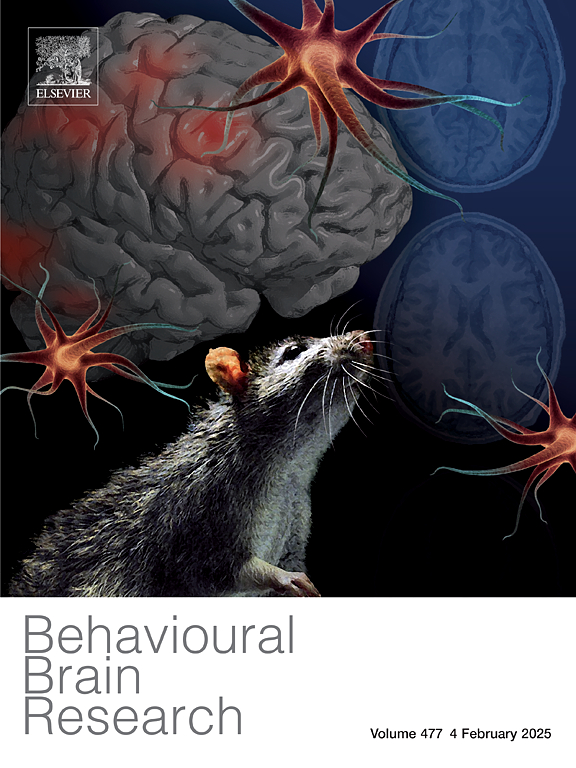应激诱导的熟练行走表现水平的认知基础:小鼠记忆和空间定向的独立作用。
IF 2.6
3区 心理学
Q2 BEHAVIORAL SCIENCES
引用次数: 0
摘要
应激对运动适应具有深刻而复杂的影响,其对熟练步行行为的影响是由认知和神经生物学因素介导的。本研究探讨了青春期不可预测的慢性轻度应激(UCMS)对雄性和雌性Balb/cJ小鼠熟练行走性能的影响。主要的焦点是识别记忆和空间取向作为运动弹性的潜在预测因素。133只小鼠使用阶梯步行测试(LRWT)评估运动熟练程度,熟练步行表现评分(SWPS)分为优秀、普通或较差。行为学评估包括巴恩斯迷宫、y型迷宫、空地迷宫和高架迷宫,用于评估认知和焦虑样行为。我们的发现揭示了压力和运动表现之间微妙的相互作用。压力暴露并不能直接预测熟练行走的结果,但会引发双重效应:一些老鼠表现出运动能力受损,另一些则表现出增强,这强调了压力适应的多因素性质。值得注意的是,巴恩斯迷宫中的初级潜伏期是SWPS的重要预测指标,每增加一秒,优异表现的可能性就会降低2%。这强调了空间定向和记忆在介导应激下运动适应中的关键作用。Bdnf外显子IV、Drd1和Drd2在感觉运动皮层的基因表达分析显示,与运动表现没有直接关联,这表明压力相关的变异可能涉及复杂的分子途径。虽然没有观察到明显的性别差异,但这些发现强调了对遗传、环境和神经生物学维度进行综合研究的必要性,以充分阐明压力诱导的运动适应,并为减轻运动缺陷提供干预措施。本文章由计算机程序翻译,如有差异,请以英文原文为准。
Cognitive underpinnings of stress-induced skilled walking performance levels: The independent roles of memory and spatial orientation in mice
Stress exerts a profound yet complex influence on motor adaptation, with its effects on skilled walking performance mediated by cognitive and neurobiological factors. This study explored the impact of unpredictable chronic mild stress (UCMS) during adolescence on skilled walking performance in male and female Balb/cJ mice. The primary focus was on identifying memory and spatial orientation as potential predictors of motor resilience. A cohort of 133 mice was evaluated using the Ladder Rung Walking Test (LRWT) to assess motor proficiency, with skilled walking performance scores (SWPS) categorized as superior, regular, or inferior. Behavioral assessments, including the Barnes maze, Y-maze, open field, and elevated plus maze, were employed to evaluate cognitive and anxiety-like behaviors. Our findings revealed a nuanced interaction between stress and motor performance. Stress exposure did not directly predict skilled walking outcomes but elicited a dual effect: while some mice exhibited impaired motor performance, others showed enhancements, emphasizing the multifactorial nature of stress adaptation. Notably, primary latency in the Barnes maze emerged as a significant predictor of SWPS, with each additional second linked to a 2 % decrease in the likelihood of superior performance. This underscores the pivotal role of spatial orientation and memory in mediating motor adaptation under stress. Gene expression analyses of Bdnf exon IV, Drd1, and Drd2 in the sensorimotor cortex revealed no direct association with motor performance, suggesting that stress-related variability may involve complex molecular pathways. While no significant sex-based differences were observed, these findings highlight the need for integrative research addressing genetic, environmental, and neurobiological dimensions to fully elucidate stress-induced motor adaptations and inform interventions to mitigate motor deficits.
求助全文
通过发布文献求助,成功后即可免费获取论文全文。
去求助
来源期刊

Behavioural Brain Research
医学-行为科学
CiteScore
5.60
自引率
0.00%
发文量
383
审稿时长
61 days
期刊介绍:
Behavioural Brain Research is an international, interdisciplinary journal dedicated to the publication of articles in the field of behavioural neuroscience, broadly defined. Contributions from the entire range of disciplines that comprise the neurosciences, behavioural sciences or cognitive sciences are appropriate, as long as the goal is to delineate the neural mechanisms underlying behaviour. Thus, studies may range from neurophysiological, neuroanatomical, neurochemical or neuropharmacological analysis of brain-behaviour relations, including the use of molecular genetic or behavioural genetic approaches, to studies that involve the use of brain imaging techniques, to neuroethological studies. Reports of original research, of major methodological advances, or of novel conceptual approaches are all encouraged. The journal will also consider critical reviews on selected topics.
 求助内容:
求助内容: 应助结果提醒方式:
应助结果提醒方式:


